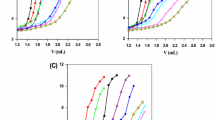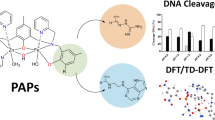Abstract
The stoichiometry and stability constants of the complexes formed between [Pd(MAMP)(H2O)2]2+ and various biologically relevant ligands containing different functional groups were investigated. The ligands used are amino acids, peptides and DNA constituents. The results show the formation of 1:1 complexes with amino acids and peptides and the corresponding deprotonated amide species. Structural effects of peptides on amide deprotonation were investigated. The purine and pyrimidine bases uracil, uridine, cytosine, inosine, inosine 5′-monophosphate (5′-IMP) and thymine form 1:1 and 1:2 complexes. The concentration distribution of the various complex species was calculated as a function of pH. The effect of chloride ion concentration on the formation constant of CBDCA with Pd(MAMP)2+ was also reported. The results show ring opening of CBDCA and monodentate complexation of the DNA constituent with the formation of [Pd(MAMP)(CBDCA-O)DNA], where (CBDCA-O) represents cyclobutane dicarboxylate coordinated by one carboxylate oxygen. The equilibrium constant of the displacement reaction of coordinated inosine, as a typical DNA constituent, by SMC and/or methionine was calculated. The results are expected to contribute to the chemistry of antitumor agents. The calculated parameters of the optimized complexes support the measured formation constants.









Similar content being viewed by others
Abbreviations
- CBDCA:
-
1,1-Cyclobutanedicarboxylic acid
- MAMP:
-
2-(Methylamino)methylpyridine
- 5′-IMP:
-
Inosine-5′-monophosphate
- 5′-GMP:
-
Guanosine-5′-monophosphate
- SMC:
-
S-methyl-l-cysteine
- DMEN:
-
N,N′-Dimethylethylenediamine
- Thr:
-
Threonine
- Ser:
-
Serine
- En:
-
Ethylenediamine
- 1,3-DAP:
-
1,3-Diaminopropane
- BPY:
-
N,N′-Bipyridyl
- α-Ala:
-
α-Alanine
- β-Ala:
-
β-Alanine
- PM3:
-
Parametric Method-3
- UV:
-
Ultraviolet
- HOMO:
-
Highest occupied molecular orbital energy
- LUMO:
-
Lowest unoccupied molecular orbital energy
- χ:
-
Mulliken electronegativity
- Pi :
-
Chemical potential
- η :
-
Global hardness
- S :
-
Global softness
- ω :
-
Global electrophilicity
References
Rosenberg, B., Van Camp, L., Trasko, J.E., Mansour, V.H.: Platinum compounds: a new class of potent antitumour agent. Nature 222, 385–386 (1969)
Wong, E., Giandomenico, C.M.: Current status of platinum-based antitumor drugs. Chem. Rev. 99, 2451–2466 (1999)
Guo, Z., Sadler, P.J.: Medicinal inorganic chemistry. Adv. Inorg. Chem. 49, 183–306 (2000)
Rosenberg, B.: In: Sigel, H. (ed.) Metal Ions in Biological Systems, vol. 11, pp. 127–196. Marcel Dekker, New York (1980)
Roberts, J.J.: In: Eichhorn, G.L., Marzilli, L.G. (eds.) Metal Ions in Genetic Information Transfer, vol. 11, pp. 273–332. Elsevier, Amsterdam (1981)
Gill, D.S.: In: Hacker, M.P., Douple, E.B. (eds.) Platinum Coordination Complexes in Cancer Chemotherapy, vol. 11, pp. 267–278. Nijhoff, Boston (1984)
Heim, M.E.: In: Keppler, B.K. (ed.) Metal Complexes in Cancer Chemotherapy, vol. 11, p. 9. VCH, Weinheim (1993)
Summa, N., Soldatović, T., Dahlenburg, L., Bugarčić, Ž.D., van Eldik, R.: Kinetics and mechanism of the substitution reactions of [PtCl(bpma)]+, [PtCl(gly-met-S,N,N)] and their aqua analogues with L-methionine, glutathione and 5`-GMP. J. Biol. Inorg. Chem. 12, 1141–1150 (2007)
Bugarčić, Ž.D., Nandibewoor, S.T., Hamza, M.S.A., Heinemann, F., Van Eldik, R.: Kinetics and mechanism of the reactions of Pd(II) complexes with azoles and diazines. Crystal structure of [Pd(bpma)(H2O)](ClO4)2·2H2O. Dalton Trans. 24, 2984–2990 (2006)
Lippert, B. (ed.): Cisplatin Chemistry and Biochemistry of Leading Anticancer Drugs. Wiley-VCH, Zürich (1999)
Wang, D., Lippard, S.J.: Cellular processing of platinum anticancer drugs. Nat. Rev. Drug Discov. 4, 307–320 (2005)
Abd El-Karim, A.T., El-Sherif, A.A.: Potentiometric, thermodynamics and coordination properties for binary and mixed ligand complexes of copper(II) with imidazole-4-acetic acid and tryptophan or phenylalanine aromatic amino acids. J. Solution Chem. 45, 712–731 (2016)
Abdelkarim, A.T., Al-Shomrani, M.M., Rayan, A.M., El-Sherif, A.A.: Mixed ligand complex formation of cetirizine drug with bivalent transition metal(II) ions in the presence of 2-aminomethylbenzimidazole: synthesis, structural, biological, pH-metric and thermodynamic studies. J. Solution Chem. 44, 1673–1704 (2015)
Rayan, A.M., Abdlkarim, A.T., Ahmed, M.M., El-Sherif, A.A., Barakat, M.H.: Complex formation of cetirizine drug with bivalent transition metal(II) ions in the presence of alanine: synthesis, characterization, equilibrium studies, and biological activity studies. J. Coord. Chem. 68, 678–703 (2015)
Abdelkarim, A.T., El-Sherif, A.A.: Physicochemical studies and biological activity of mixed ligand complexes involving bivalent transition metals with a novel Schiff base and glycine as a representative amino acid. J. Eur. Chem. 5, 328–333 (2014)
Aljahdali, M.S., Abdelkarim, A.T., El-Sherif, A.A., Ahmed, M.M.: Synthesis, characterization, equilibrium studies, and biological activity of complexes involving copper(II), 2-aminomethylthiophenyl-4-bromosalicylaldehyde Schiff base, and selected amino acids. J. Coord. Chem. 67, 870–890 (2014)
Aljahdali, M., El-Sherif, A.A., Shoukry, M.M., Hosny, W.M., Abd-Elmoghny, M.G.: Complex formation equilibria of unusual seven coordinate Fe(III) complexes with DNA constituents. J. Solution Chem. 42, 1663–1679 (2013)
El-Sherif, A.A., Shoukry, M.M., Abd-Elgawad, M.M.A.: Protonation equilibria of some selected α-amino acids in DMSO–water mixture and their Cu(II)-complexes. J. Solution Chem. 42, 412–427 (2013)
El-Sherif, A.A., Shoukry, M.M.: The palladium(II)-picolylamine promoted hydrolysis of amino acid esters; kinetic evidence for inter- and intramolecular mechanisms. J. Progr. React. Kinet. Mech 36, 215–226 (2011)
El-Sherif, A.A.: Synthesis and characterization of some potential antitumor palladium(II) complexes of 2-aminomethylbenzimidazole and amino acids. J. Coord. Chem. 64, 2035–2055 (2011)
El-Sherif, A.A., Shoukry, M.M., El-Bahnasawy, R.M., Ahmed, D.M.: Complex formation reactions of palladium(II)-1,3-diaminopropane with various biologically relevant ligands. Kinetics of hydrolysis of glycine methyl ester through complex formation. Cent. Eur. J. Chem. 8, 919–927 (2010)
Rau, T., Van Eldik, R.: In: Sigel, A., Sigel, H. (eds.) Metal Ions in Biological Systems, p. 340. Marcel Dekker, New York (1996)
Shoukry, M.M., Shehata, M.R., Abdel-Razik, A., Abdel-Karim, A.T.: Equilibrium studies of mixed ligand complexes involving (1,2-diaminopropane)-palladium(II) and some bioligands. Monatsh. Chem. 130, 409–423 (1999)
El-Sherif, A.A., Shoukry, M.M., van Eldik, R.: Complex-formation reactions and stability constants for mixed–ligand complexes of diaqua(2-picolylamine)palladium(II) with some bio-relevant ligands. J. Chem. Soc., Dalton Trans. 7, 1425–1432 (2003)
Rau, T., Shoukry, M.M., van Eldik, R.: Complex formation and ligand substitution reactions of (2-picolylamine)palladium(II) with various biologically relevant ligands. Characterization of (2-picolylamine)(1,1-cyclobutanedicarboxylato)palladium(II). Inorg. Chem. 36, 1454–1463 (1997)
Mohamed, M.M.A., Shoukry, M.M.: Complex formation reactions of (N,N′-dimethylethylenediamine) palladium(II) with various biologically relevant ligands. Polyhedron 20, 343–352 (2001)
Bates, R.G.: Determination of pH-Theory and Practice, 2nd edn. Wiley, New York (1975)
Stark, J.G., Wallace, H.G. (eds.): Chemistry Data Book, p. 75. Murray, London (1975)
Gans, P., Sabatini, A., Vacca, A.: An improved computer program for the computation of formation constants from potentiometric data. Inorg. Chim. Acta 18, 237–239 (1976)
Pettit, L.: University of Leeds, Personal Communication
HyperChem version 7.5. Hypercube, Inc. (2003)
Perrin, D.D.: Stability Constants of Metal-Ion Complexes: Part B Organic Ligands. Pergamon Press, Oxford (1979)
Shehata, M.R.: Mixed ligand complexes of diaquo(2,2′-bipyridine)palladium(II) with cyclobutane-1,1-dicarboxylic acid and DNA constituents. Trans. Met. Chem. 26, 198–204 (2001)
Lim, M.C.: Mixed–ligand complexes of palladium. Diaqua(ethylenediamine)palladium(II) complexes of ethanolamine, l-serine, l-threonine, l-homoserine, and l-hydroxyproline. Inorg. Chem. 20, 1377–1379 (1981)
El-Sherif, A.A.: Coordination chemistry of palladium(II) ternary complexes with relevant biomolecules. In: Stoichiometry and Research, The Importance of Quantity in Biomedicine, pp. 79–120. In-Tech Publisher, Rijeka (2012)
Shehata, M.R., Shoukry, M.M., Nasr, F.M.H., van Eldik, R.: Complex-formation reactions of dicholoro(S-methyl-L-cysteine) palladium(II) with bio-relevant ligands. Labilization induced by S-donor chelates. Dalton Trans. 6, 779–786 (2008)
Lim, M.C.: Mixed-ligand complexes of palladium(II). Part 1. Diaqua(ethylenediamine)palladium(II) complexes of glycylglycine and glycinamide. J. Chem. Soc., Dalton Trans. 1, 15–17 (1977)
Martin, R.B.: Nucleoside sites for transition metal ion binding. Acc. Chem Res. 18, 32–38 (1985)
Maskos, K.: Spectroscopic studies on the copper(II)–inosine system. J. Inorg Biochem. 25, 1–14 (1985)
Sigel, H., Massoud, S.S., Corfu, N.A.: Comparison of the extent of macrochelate formation in complexes of divalent metal ions with guanosine (GMP2−), inosine (IMP2−), and adenosine 5’-monophosphate (AMP2−). The crucial role of N-7 basicity in metal ion–nucleic base recognition. J. Am. Chem. Soc. 116, 2958–2971 (1994)
Shoukry, M.M., van Eldik, R.: Correlation between kinetic and thermodynamic complex-formation constants for the interaction of bis(amine)palladium(II) with inosine, inosine 5′-monophosphate and guanosine 5′-monophosphate. J. Chem. Soc., Dalton Trans. 13, 2673–2678 (1996)
Shoukry, M.M., Hohmann, H., van Eldik, R.: Mechanistic information on the reaction of model palladium(II) complexes with purine nucleosides and 5′-nucleotides in reference to the antitumor activity of related platinum complexes. Inorg. Chim. Acta 198, 187–192 (1992)
Ano, S.O., Intini, F.P., Natile, G., Marzilli, L.G.: Viewing early stages of guanine nucleotide attack on Pt(II) complexes designed with in-plane bulk to trap initial adducts. Relevance to cis-type Pt(II) anticancer drugs. J. Am. Chem. Soc. 119, 8570–8571 (1977)
Kiser, D., Intini, F.P., Xu, Y., Natile, G., Marzilli, L.G.: Atropisomerization of cis-bis(5’GMP)–platinum(II)–diamine complexes with non-C2-symmetrical asymmetric diamine ligands containing NH groups directed to one side of the coordination plane. Inorg. Chem. 33, 4149–4158 (1994)
Frey, U., Ranford, J.D., Sadler, P.J.: Ring-opening reactions of the anticancer drug carboplatin: NMR characterization of cis-[Pt(NH3)2(CBDCA-O)(5`-GMP-N7)] in solution. Inorg Chem. 32, 1333–1340 (1993)
Rau, T., Alsfasser, R., Zahl, A., Van Eldik, R.: Structural and kinetic studies on the formation of platinum(II) and palladium(II) complexes with l-cysteine-derived ligands. Inorg. Chem. 37, 4223–4230 (1998)
Lemma, K., Elmroth, S.K.C., Elding, L.I.: Substitution reactions of [Pt(dien)Cl]+, [Pt(dien)(GSMe)]2+, cis-[PtCl2(NH3)2] and cis-[Pt(NH3)2(GSMe)2]2+ (GSMe = S-methylglutathione) with some sulfur-bonding chemoprotective agents. J. Chem. Soc., Dalton Trans. 7, 1281–1286 (2002)
Provosta, K., Bouvet-Mullera, D., Crauste-Manciet, S., Moscovicia, J., Olivid, L., Vlaicd, G., Michalowicza, A.: EXAFS structural study of platinum-based anticancer drugs degradation in presence of sulfur nucleophilic species. Biochimie 91, 1301–1306 (2009)
Alden, W.W., Repta, A.J.: Exacerbation of cisplatin-induced nephrotoxicity by methionine. Chem. Biol. Interact. 48, 121–124 (1984)
Pearson, R.G.: Absolute electronegativity and hardness: applications to organic chemistry. J. Org. Chem. 54, 1423–1430 (1989)
Geerlings, P., De Proft, F., Langenaeker, W.: Conceptual density functional theory. Chem. Rev. 103, 1793–1874 (2003)
Parr, R.G.: Electrophilicity index. J. Am. Chem. Soc. 121, 1922–1924 (1999)
Chattaraj, P.K., Giri, S.: Stability, reactivity, and aromaticity of compounds of a multivalent superatom. J. Phys. Chem. A 111, 11116–11121 (2007)
Speie, G., Csihony, J., Whalen, A.M., Pie-Pont, C.G.: Studies on aerobic reactions of ammonia/3,5-ditert-butylcatechol Schiff-base condensation products with copper, copper(I), and copper(II). Strong copper(II)-radical ferromagnetic exchange and observations on a unique N-N coupling reaction. Inorg. Chem. 35, 3519–3535 (1996)
Aihara, J.: Reduced HOMO–LUMO gap as an index of kinetic stability for polycyclic aromatic hydrocarbons. J. Phys. Chem. A 103, 7487–7495 (1999)
Haddon, R.C., Fukunaga, T.: Absolute hardness as a measure of aromaticity. Tetrahedron Lett. 29, 4843–4846 (1988)
Parr, R.G., Chattara, P.K.: Principle of maximum hardness. J. Am. Chem. Soc. 113, 1854–1855 (1991)
Author information
Authors and Affiliations
Corresponding authors
Electronic supplementary material
Below is the link to the electronic supplementary material.
Rights and permissions
About this article
Cite this article
Abd El-Karim, A.T., El-Sherif, I.R., Hosny, W.M. et al. Potentiometric and Speciation Studies on the Complex Formation Reactions of [Pd(2-methylaminomethyl)-pyridine)(H2O)2]2+ with Some Bio-active Ligands and Displacement Reaction of Coordinated Inosine. J Solution Chem 46, 1024–1047 (2017). https://doi.org/10.1007/s10953-017-0621-z
Received:
Accepted:
Published:
Issue Date:
DOI: https://doi.org/10.1007/s10953-017-0621-z




